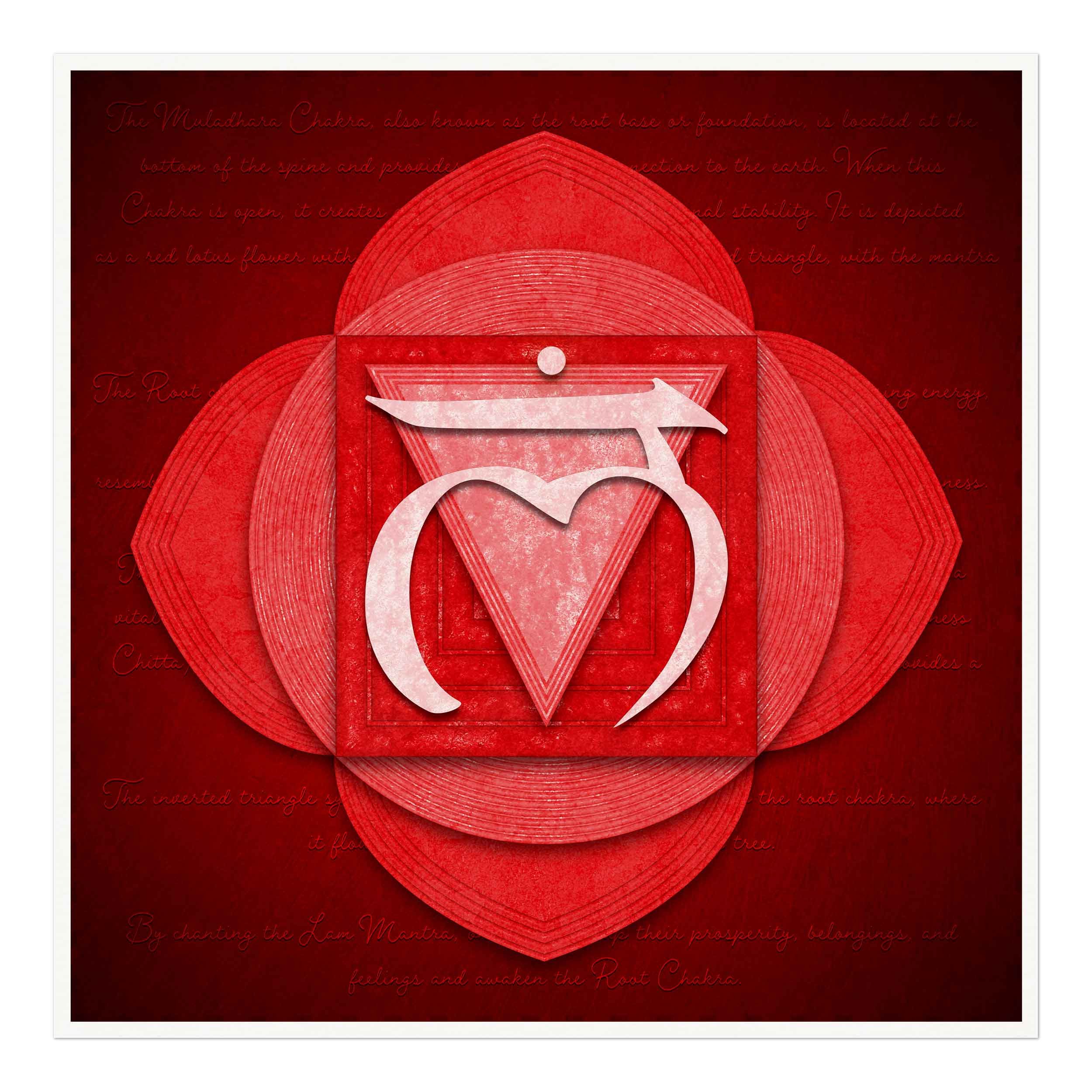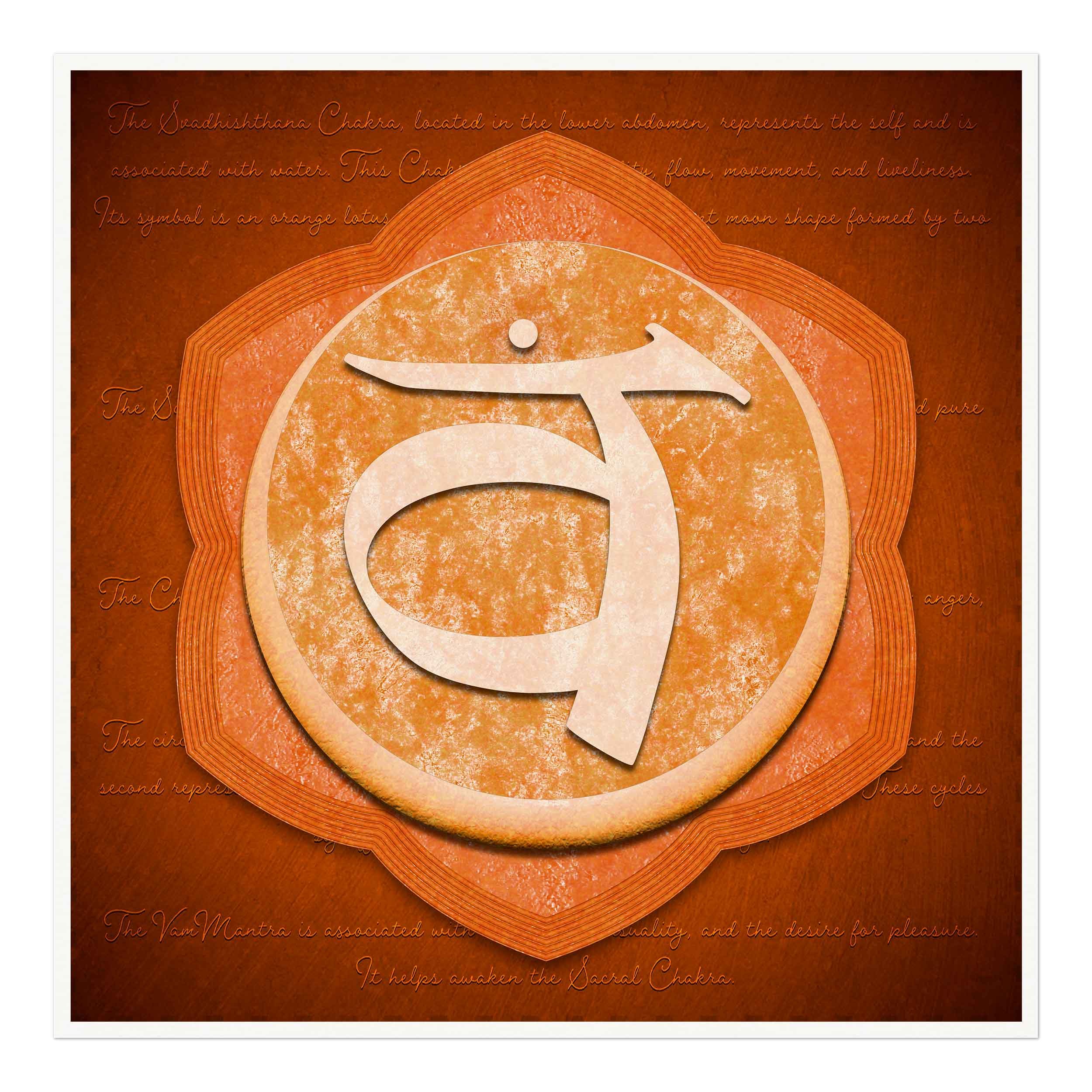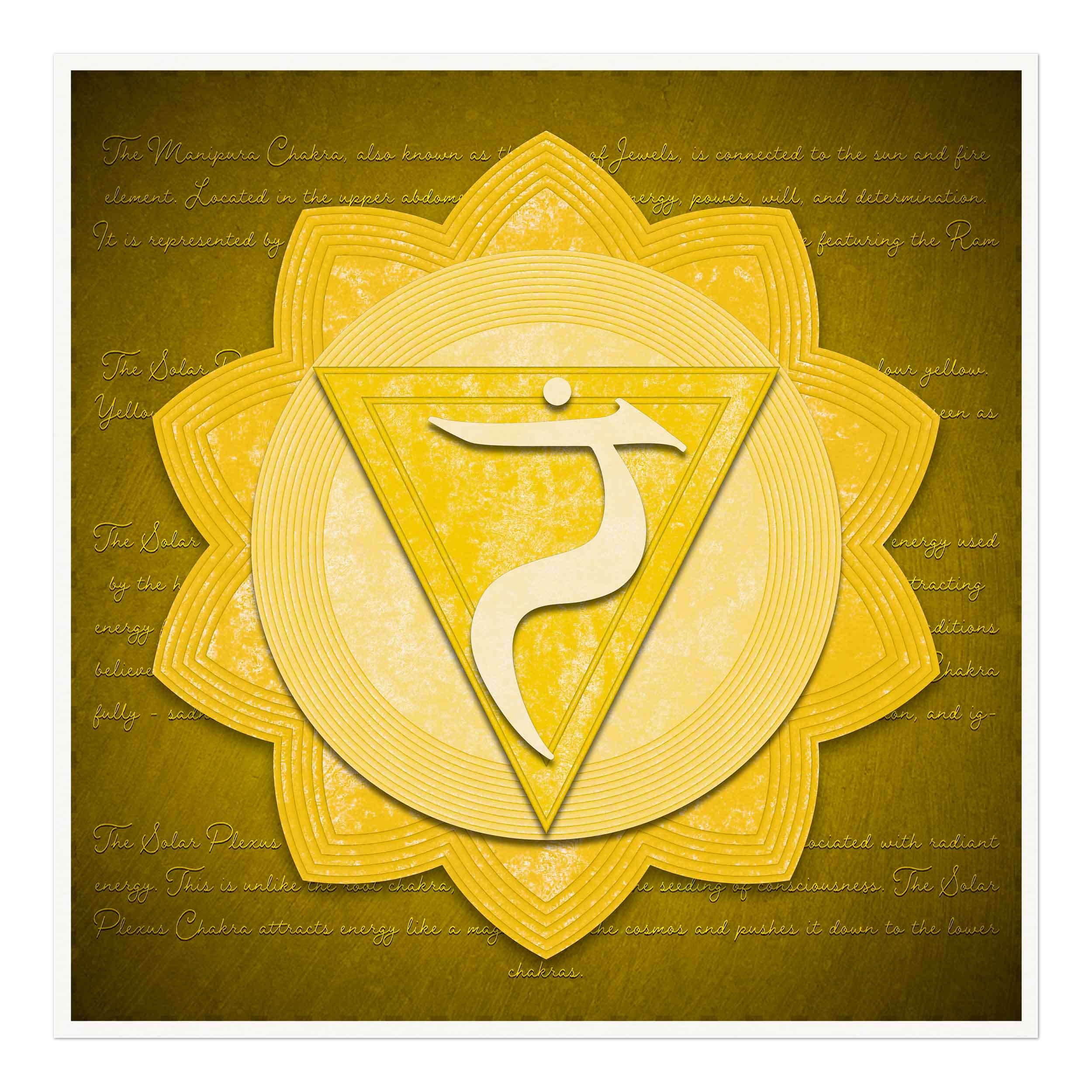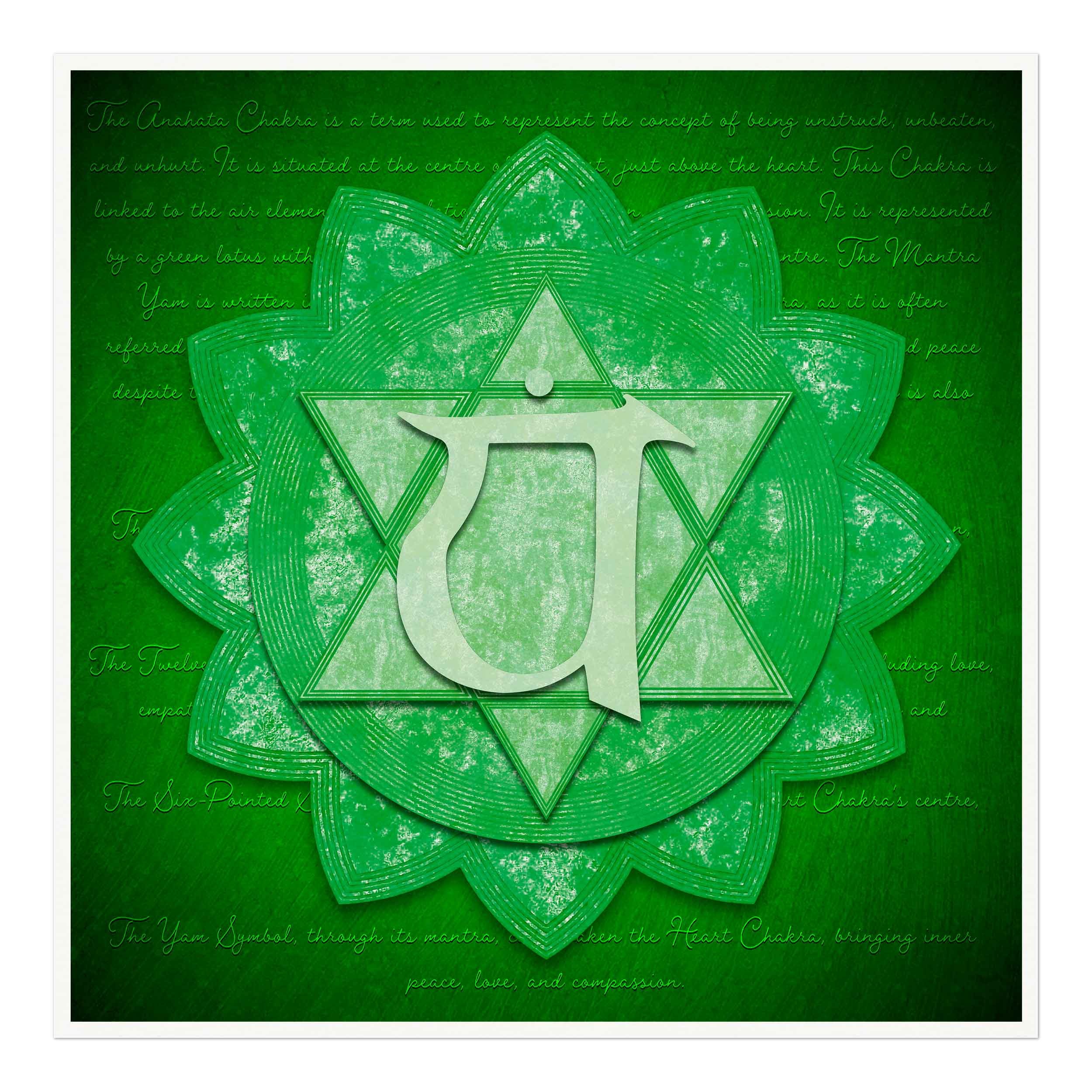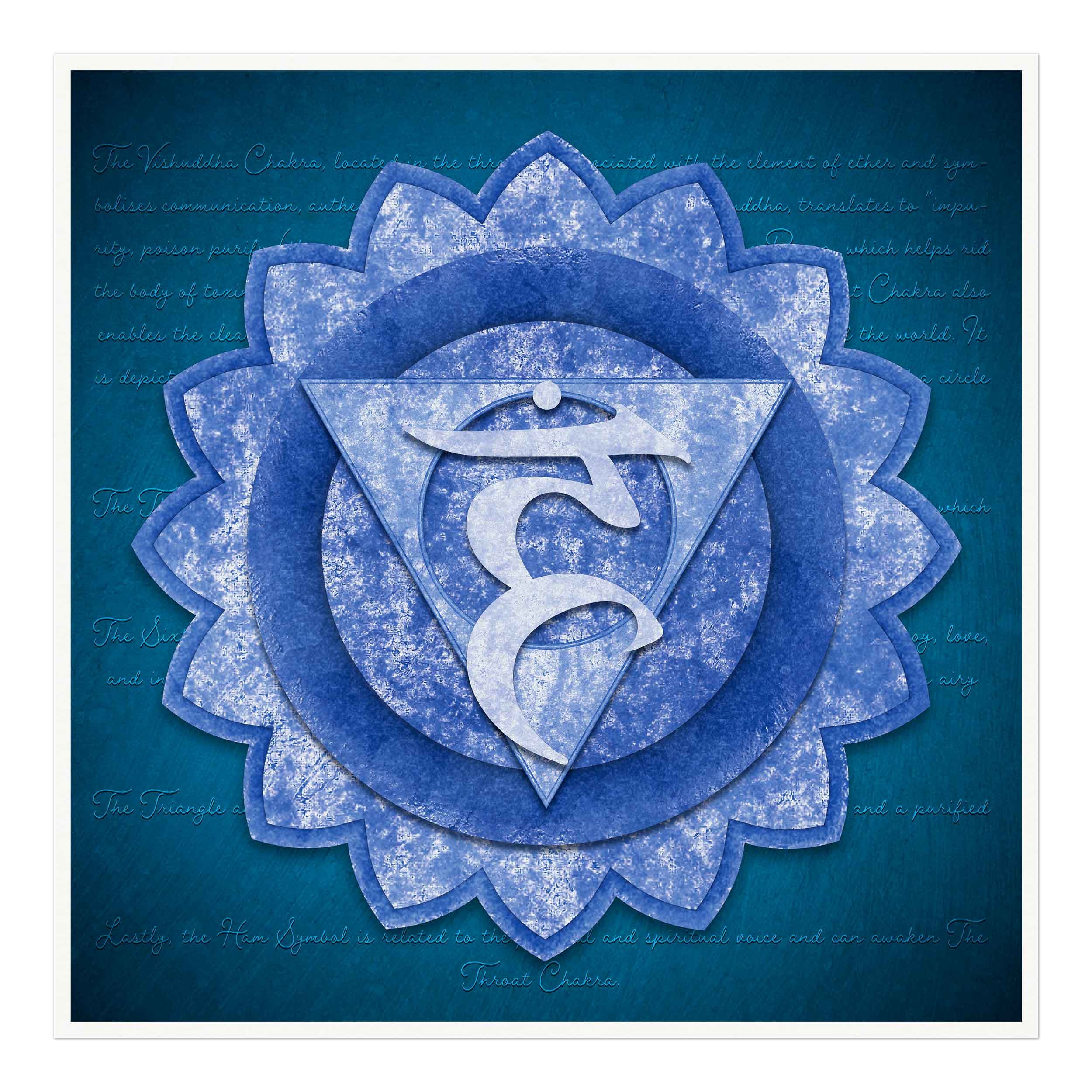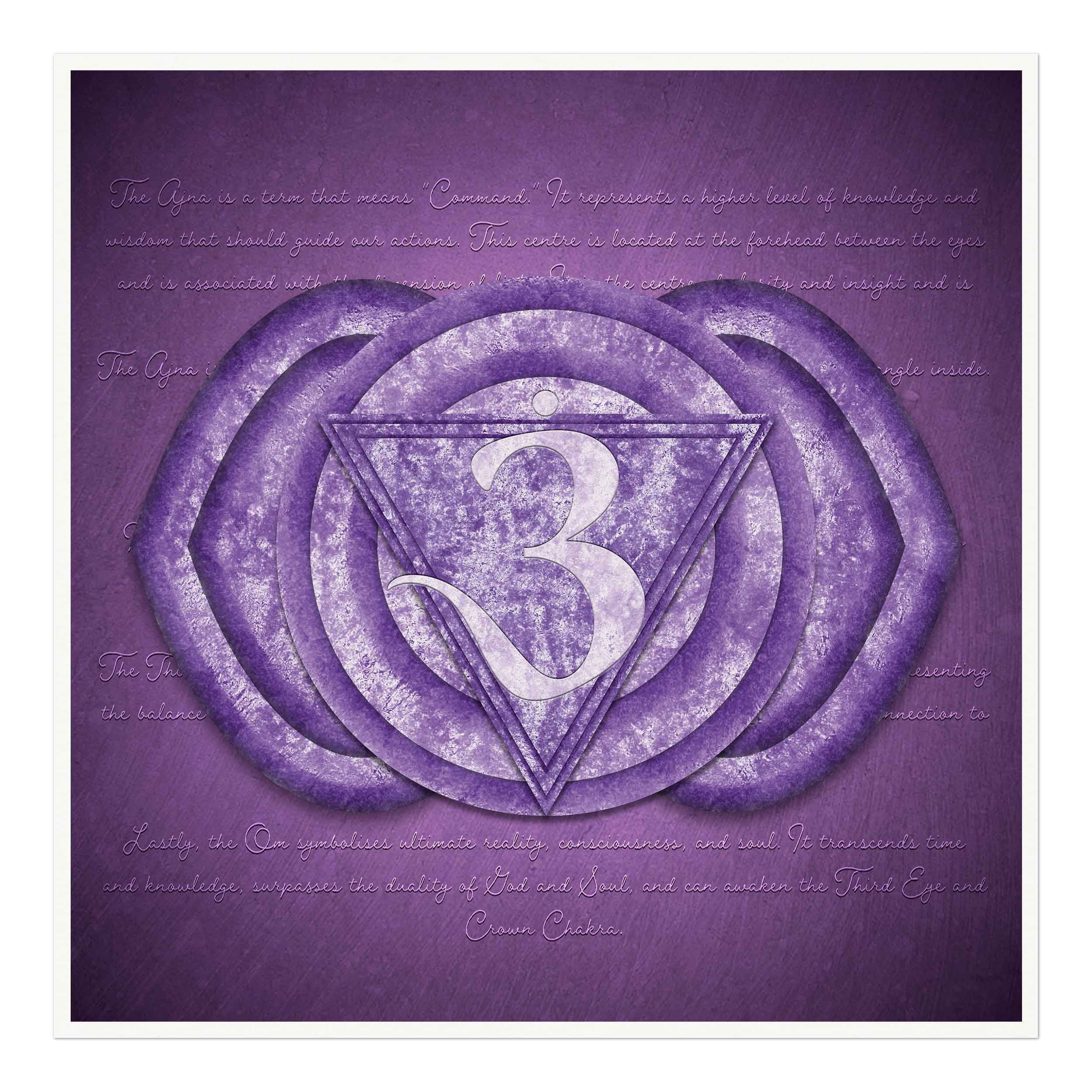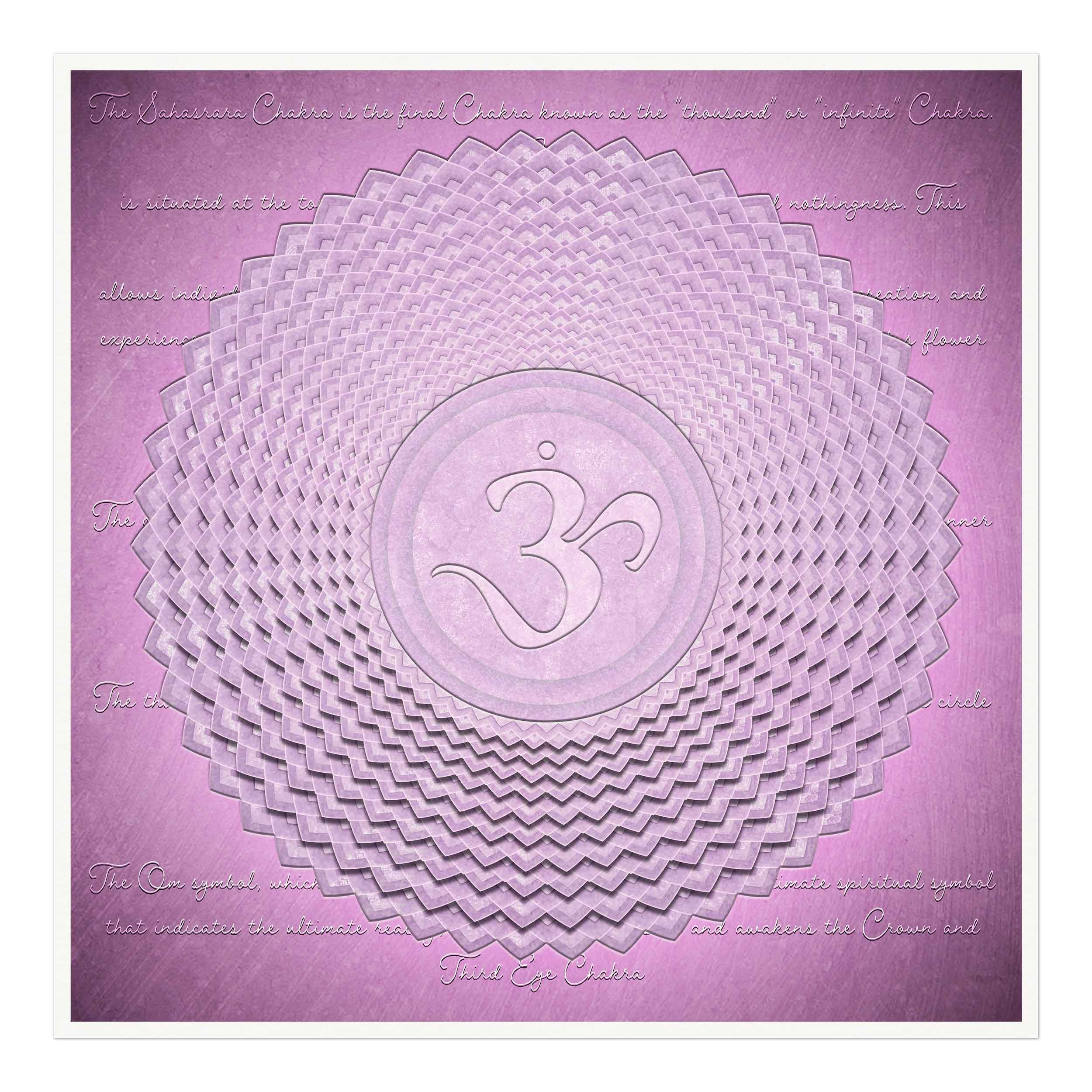Discover The Seven Chakras: A Guide to Their Symbols and Meanings.
When I was younger, I was determined to find a balance that would bring me mental and physical happiness. Although I've faced challenges and made mistakes, I've always tried to focus on the positives. In today's world, it's more important than ever to spread love instead of hate.
While searching for balance, I discovered the Seven Chakras: Root, Sacral, Solar Plexus, Heart, Throat, Third Eye, and Crown. Each Chakra has its unique attributes that, when activated correctly, can contribute to a more balanced and healthier lifestyle.
When I initially set out to create The Spiritual Awakening, a piece of digital art, I wanted to incorporate the chakras to represent the connection between the earth and the spirit during meditation. Despite being unsatisfied with the initial design, which featured flat and unremarkable vectors created using Adobe Illustrator, I continued to work on it by experimenting with various textures and backgrounds in Photoshop. After many attempts, I ultimately returned to Illustrator to utilise its new 3D features, which improved the chakras beyond my expectations. You can still find the original chakras in The Spiritual Awakening, which has since gone viral on Pinterest and become one of my best-selling prints.
What is a Chakra?
Translated from Sanskrit, the term means ‘Wheel’ or ‘Disk’. These ‘wheels’ are said to be spinning wheels aligned in the centre of the body, starting from the base of your spine to the crown of your head, regulating all parts of the bodily system, influencing everything from emotional processing to resistance to disease.
I read there are 114 different chakras located somewhere outside of the body, but for this blog, I will stick to the primary seven; feel free to do some research on the 114 chakras. I would love to hear your results.
The Seven Chakras in Depth

The Root Chakra: A Source of Foundation and Stability
The Appearance of the Root Chakra
The Muladhara Chakra, also known as the root base or foundation, is located at the bottom of the spine and provides a grounding connection to the earth. When this Chakra is open, it creates a sense of physical and emotional stability. It is depicted as a red lotus flower with four petals, a square, and an inverted triangle, with the mantra LAM at its centre.
Symbolic Meaning
The Root chakra holds significant meaning. It is associated with red, symbolising energy, awakening, movement, and evolution. Specifically, in the root chakra, red resembles the dawn and represents the transition from a passive state to active awareness.
The lotus flower that represents the root chakra has four petals, each representing a vital aspect of the human psyche:
- Manas (मनस्) – Mind
- Buddhi (बुद्धि) – Intellect
- Chitta (चित्त) – Consciousness
- Ahaṃkāra (अहंकार) – Ego
The square shape is a stable structure that provides a foundation for the other chakras to rest upon.
The inverted triangle symbolises the seeding of consciousness into the root chakra, where it flourishes and grows like the roots of a tree.
The LAM Mantra
By embracing the powerful mantra "LAM," we unlock vibrant pathways leading to abundance, cherished possessions, and profound emotional bonds. This transformative practice awakens the root chakra, grounding us in our essence and enabling us to realise our fullest potential. Through this journey, we invite prosperity and deep connections into our lives, fostering a harmonious balance between our inner selves and the world around us.
Grounded and Strong: Meditation and Yoga for the Root Chakra
The Root Chakra, or Muladhara, is the first of the seven primary chakras in the body. Located at the base of the spine, it is associated with feelings of safety, stability, and grounding. When this chakra is balanced, we feel secure, present, and confident in our ability to meet life’s challenges. When it is imbalanced, we may experience anxiety, fear, or a persistent sense of restlessness.
Meditation for the Root Chakra
The Root Chakra, or Muladhara, is the first of the seven primary chakras in the body. Located at the base of the spine, it is associated with feelings of safety, stability, and grounding. When this chakra is balanced, we feel secure, present, and confident in our ability to meet life’s challenges. When it is imbalanced, we may experience anxiety, fear, or a persistent sense of restlessness.
Root chakra meditations help you reconnect with your physical body and the Earth. These practices often involve grounding visualisations, breathwork, and affirmations.
Meditate for 5–10 minutes daily, gradually extending your practice as it feels natural.
Yoga Poses to Balance the Root Chakra
Certain yoga asanas (postures) are particularly effective for stimulating and balancing the Muladhara. These include poses that encourage contact with the ground and strengthen the legs and pelvic region.
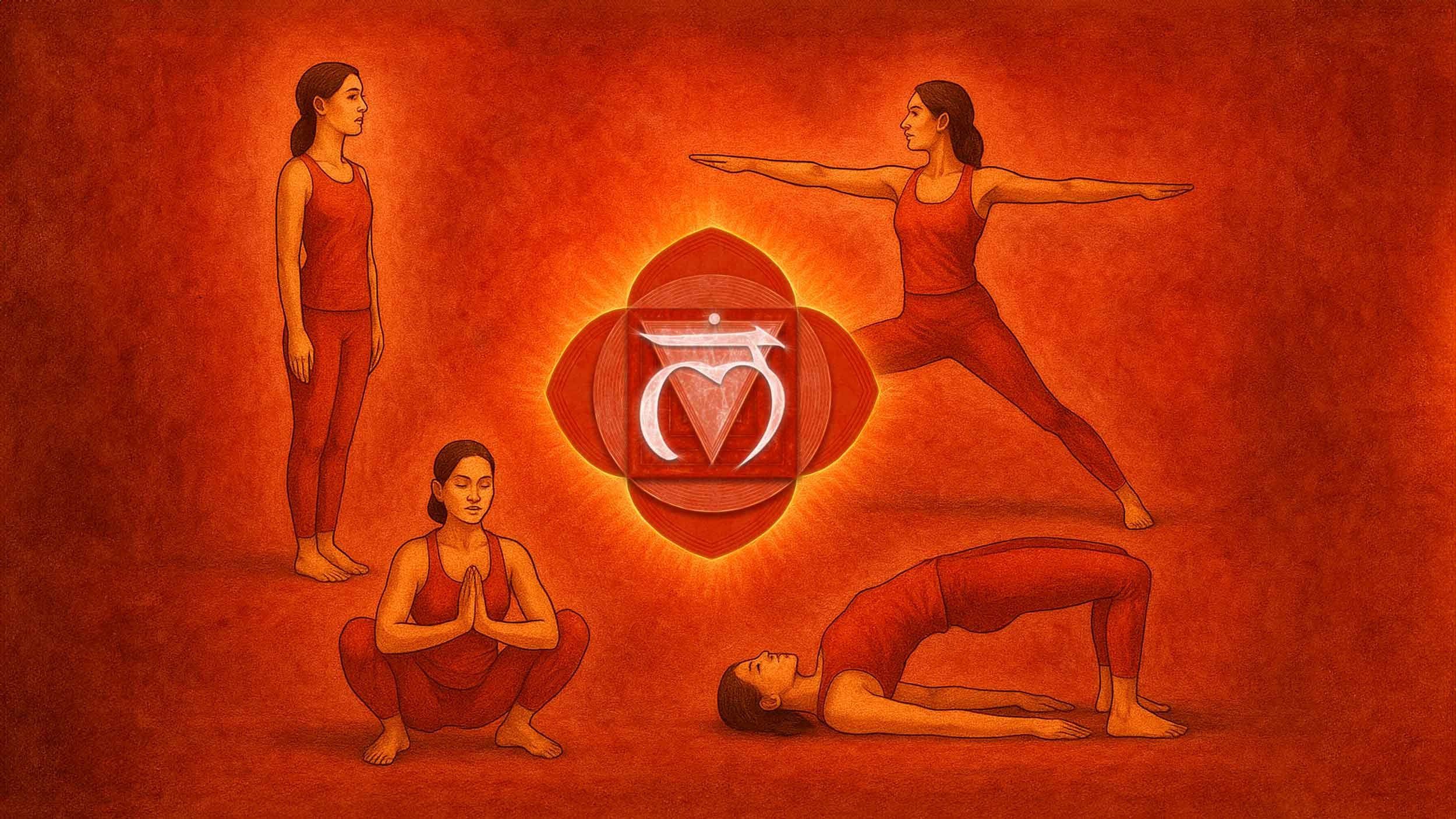
- Mountain Pose (Tadasana) – Promotes a sense of stillness and connection to the Earth.
- Warrior I and II (Virabhadrasana I & II) – Build strength and confidence. – Build strength and confidence.
- Garland Pose (Malasana) – Opens the hips and grounds energy.
- Child’s Pose (Balasana) – Offers safety and rest.
- Bridge Pose (Setu Bandhasana) – Strengthens the lower body and brings awareness to the base of the spine.
By nurturing the Root Chakra through consistent meditation and yoga practice, you establish a powerful foundation for emotional resilience and inner strength.

The Sacral Chakra: A Powerful Source of Creativity and Passion
The Appearance of the Sacral Chakra
The Svadhishthana Chakra , located in the lower abdomen, represents the self and is associated with water. This Chakra signifies fluidity, flow, movement, and liveliness. Its symbol is an orange lotus with six petals, with a crescent moon shape formed by two circles at its centre. The mantra VAM is written at the centre of the lotus.
Symbolic Meaning
The Sacral Chakra is represented by orange, symbolising activity, aliveness, and pure energy. Buddhist monks often wear this colour.The Chakra's six petals signify six qualities that must be overcome to purify it:
- Kāma (काम) – Desire
- Krodha (क्रोध) – Anger
- Lobh (लोभ) – Greed
- Moha (मोह) – Delusion
- Mada (मद) – Pride
- Mātsarya (मात्सर्य) – Jealousy
The circles in the Chakra symbolise cycles, with the first representing the sun and the second representing the moon, forming the well-known lunar phase symbol. These cycles signify constant movement and lasting change.
The VAM Mantra
The VAM Mantra is intricately connected to the realms of sexuality, sensuality, and the pursuit of pleasure. Its profound vibrations serve to awaken and invigorate the Sacral Chakra, the energy center associated with creativity, passion, and emotional expression. By reciting this mantra, one can explore deeper layers of desire and a fuller appreciation of life's pleasures, fostering a sense of empowerment and openness in one's intimate experiences.
Flow and Feeling: Meditation and Yoga for the Sacral Chakra
The Sacral Chakra, or Svadhisthana, is the second chakra in the traditional system of energy centres within the body. It governs our emotions, creativity, sensuality, and ability to experience pleasure. Located in the lower abdomen, just below the navel, this chakra is associated with the element of water, a symbol of fluidity, adaptability, and emotional depth.
When the Sacral Chakra is balanced, we are connected to our feelings, enjoy creative expression, and form healthy, passionate relationships. An imbalance, however, may lead to emotional instability, creative blocks, or disconnection from one’s body.
Meditation for the Sacral Chakra
Meditation for the Sacral Chakra often involves visualisations centred around water and the colour orange. These meditations encourage emotional release, creative stimulation, and connection with the body.
Practice this for 10–15 minutes to support emotional healing and creative reconnection.
Yoga Poses to Balance the Sacral Chakra
The Sacral Chakra thrives on hip-opening postures, gentle flows, and movements that mimic the qualities of water. These poses help release stored emotions and bring attention to the pelvic area.
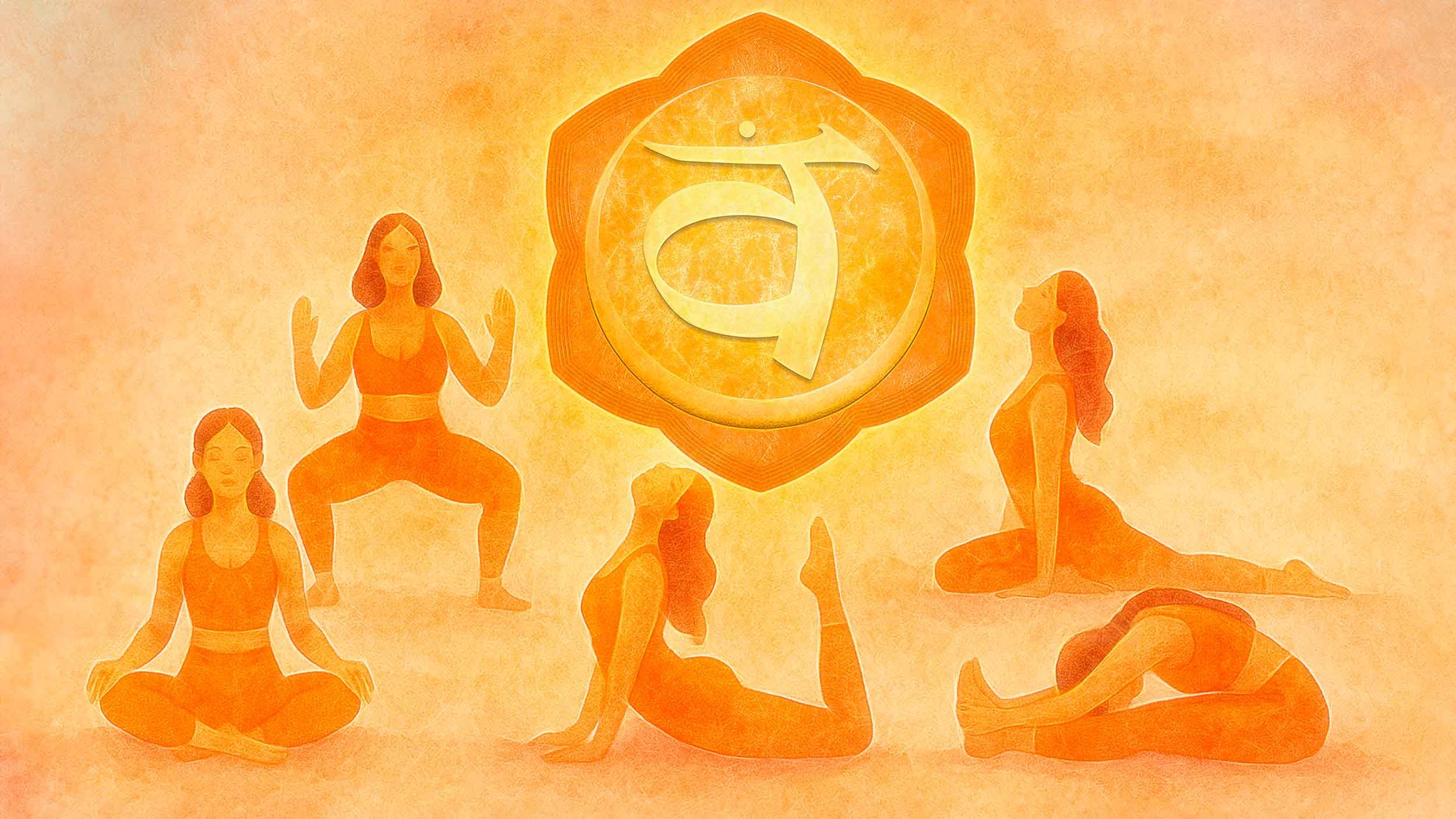
- Bound Angle Pose (Baddha Konasana) – Opens the hips and encourages emotional release.
- Goddess Pose (Utkata Konasana) – Strengthens the lower body and invites inner power.
- Pigeon Pose (Eka Pada Rajakapotasana) – Deeply stretches the hips and unlocks tension.
- Cat-Cow Flow (Marjaryasana-Bitilasana) – Stimulates spinal and pelvic movement.
- Seated Forward Bend (Paschimottanasana) – Encourages introspection and flow of energy.
Balancing the Sacral Chakra is about honouring your emotions, finding joy in your body, and letting creativity flow freely. Through intentional meditation and yoga, you can gently restore harmony to this vital energy centre — unlocking a deeper connection with yourself and others.

The Solar Plexus Chakra: A Source of Powerful Energy and Personal Empowerment
The Appearance of the Solar Plexus Chakra
The Manipura Chakra , also known as the City of Jewels, is connected to the sun and fire element. Located in the upper abdomen, it symbolises energy, power, will, and determination. It is represented by a yellow lotus with ten petals and an inverted triangle featuring the RAM Mantra at its centre.
Symbolic Meaning
The Solar Plexus Chakra holds great significance and is associated with the colour yellow. Yellow is associated with fire and the sun, symbolising energy. In Hinduism, yellow is seen as a symbol of meditation, competence, and mental development.
The Solar Plexus Chakra has ten petals, which symbolises ten mental-emotional blockages:
- Aalasya (आलस्य) - Laziness
- Shoka (शोक) - Sadness
- Moha (मोह) - Delusion
- Ghrina (घृणा) - Disgust
- Bhaya (भय) - Fear
- Lajja (लज्जा) - Shame
- Pishunatā (पिशुनता) - Foolishness
- Irṣyā (ईर्ष्या) - Jealousy
- Trishna (तृष्णा) - Ambition
- Avidyā (अविद्या) - Spiritual Ignorance
When open, the petals act as a magnet, attracting energy from the cosmos and making it usable for the human body. Alternatively, some traditions believe that the petals represent ten blocking qualities that must be overcome to open the Chakra fully - sadness, foolishness, delusion, disgust, fear, shame, betrayal, jealousy, ambition, and ignorance.
The Solar Plexus Chakra is also represented by an inverted triangle associated with radiant energy. This is unlike the root chakra, which symbolises the seeding of consciousness. The Solar Plexus Chakra attracts energy like a magnet from the cosmos and pushes it down to the lower chakras.
The RAM Mantra
The RAM Symbol is also vital as it controls one's destiny and awakens the Solar Plexus Chakra, making one feel powerful.The RAM symbol holds incredible significance, as it intricately weaves the threads of destiny and ignites the Solar Plexus Chakra, imbuing the individual with a radiant sense of power and confidence.
Power and Purpose: Meditation and Yoga for the Solar Plexus Chakra
The Solar Plexus Chakra, known in Sanskrit as Manipura, is the third chakra and the seat of our personal power. Located in the upper abdomen, just above the navel, it governs our sense of identity, self-confidence, motivation, and willpower. When this chakra is balanced, we feel empowered, focused, and in control of our lives. When it is imbalanced, we may experience low self-esteem, indecision, or a tendency to over-control.
Meditation for the Solar Plexus Chakra
Solar Plexus Chakra meditation focuses on building inner strength, releasing fear, and cultivating self-belief. The colour yellow and visualisations of light or fire are often used to energise this chakra.
Try this for 10 minutes, especially in the morning to energise and focus your intentions.
Yoga Poses to Balance the Solar Plexus Chakra
Yoga for the Solar Plexus Chakra targets the core, digestive organs, and abdominal region, helping to awaken your inner fire (Agni) and develop personal discipline.
- Boat Pose (Navasana) – Builds core strength and mental resilience.
- Warrior III (Virabhadrasana III) – Develops balance, focus, and confidence.
- Plank Pose (Phalakasana) – Ignites physical and mental stamina.
- Bow Pose (Dhanurasana) – Stimulates digestion and energises the entire torso.
- Twisting Poses (e.g., Revolved Triangle or Supine Twist) – Aid digestion and detoxify.
The Solar Plexus Chakra is your inner engine, the fire that fuels transformation, purpose, and action. When aligned, you feel courageous, capable, and connected to your goals. Through focused meditation and energising yoga, you can awaken this powerful centre and take empowered steps toward your highest potential.

The Heart Chakra: A Gateway to Love, Compassion, and Connection.
The Appearance of the Heart Chakra
The Anahata Chakra is a term used to represent the concept of being unstruck, unbeaten, and unhurt. It is situated at the centre of the chest, just above the heart. This Chakra is linked to the air element, love, relationship, connection, and compassion. It is represented by a green lotus with twelve petals and a six-pointed star in the centre. The Mantra YAM is written in the middle of the Chakra. The Heart Chakra, as it is often referred to, is always untouched at its deepest core, remaining in eternal love and peace despite the negative aspects of daily life and the pursuit of a perfect world. It is also associated with the heart as its source.Symbolic Meaning
The Heart Chakra holds significant meaning and is associated with the colour green, representing life and nature and evoking feelings of peace and happiness.The Twelve-Petaled Lotus symbolises twelve divine qualities of the heart:
- Āsa (आशा) - Hope
- Cintā (चिन्ता) - Anxiety
- Cittam (चित्तम्) - Consciousness
- Dambha (दम्भ) - Arrogance
- Vikalatā (विकलता) - Indecision
- Ahankāra (अहंकार) - Ego
- Mamada (ममद) - Possessiveness
- Dvesha (द्वेष) - Hatred
- Abhimāna (अभिमान) - Conceit
- Līlā (लीला) - Playfulness
- Kaksha (कक्ष) - Affection
- Pīriti (प्रीति) - Love
The Six-Pointed Star, made of two triangles, represents the Heart Chakra's centre, balancing spiritual and physical energies.
The YAM Mantra
The YAM Symbol, with its profound mantra, has the powerful ability to awaken the Heart Chakra, fostering a deep sense of inner peace, unconditional love, and boundless compassion. This sacred representation resonates with the energies of the heart, inviting a transformation that nurtures emotional healing and harmonious connections with oneself and others. By embracing the essence of the YAM Symbol, one can embark on a journey toward a more fulfilling and loving existence.
Love and Compassion: Meditation and Yoga for the Heart Chakra
The Heart Chakra, known as Anahata in Sanskrit, is the fourth chakra and the bridge between the physical and spiritual. Located in the centre of the chest, it governs our ability to love, both ourselves and others, and to experience compassion, empathy, and emotional connection. When the Heart Chakra is open and balanced, we feel peaceful, kind, and able to give and receive love freely.An imbalanced heart chakra, however, can lead to emotional withdrawal, grief, jealousy, or difficulty in trusting others.
Meditation for the Heart Chakra
Heart Chakra meditation is centred around breath, compassion, and the colour green. Visualisations and affirmations focused on love and emotional healing can help release blockages and soften emotional wounds.
Practice for 10 minutes a day, especially when dealing with emotional stress or relationship challenges.
Yoga Poses to Open the Heart Chakra
Heart-opening yoga poses focus on expanding the chest, shoulders, and upper back, helping release emotional tension and foster vulnerability and compassion.
- Camel Pose (Ustrasana) – Deep chest opener that promotes emotional release.
- Cobra Pose (Bhujangasana) – Gently opens the front body and strengthens the spine.
- Bridge Pose (Setu Bandhasana) – Opens the heart while grounding the lower body.
- Upward-Facing Dog (Urdhva Mukha Svanasana) – Energises and expands the chest.
- Humble Warrior (Baddha Virabhadrasana) – Cultivates strength, surrender, and humility.
Move slowly and mindfully, focusing on breath and sensation to avoid force and encourage emotional openness.
The Heart Chakra invites us to live with compassion, connection, and courage. By tuning in to this centre through meditation, yoga, and mindful living, we begin to break through fear and pain, allowing love to guide us. Whether you’re seeking emotional healing or simply deeper connections, working with Anahata is a gentle and powerful path to peace.

The Throat Chakra: A Powerful Source of Expression and Authenticity
The Appearance of the Throat Chakra
The Vishuddha Chakra, located in the throat, is associated with the element of ether and symbolises communication, authenticity, and purification. Its name, Vishuddha, translates to "impurity, poison purify (the purifier)" due to the energy known as Udana Prana, which helps rid the body of toxins while breathing and release suppressed negativity. The Throat Chakra also enables the clear expression of our inner thoughts and dreams to ourselves and the world. It is depicted as a blue lotus with sixteen petals, an inverted triangle in the centre, and a circle within the triangle. The mantra HAM is written in the centre as well.
Symbolic Meaning
The Throat Chakra represents communication and wisdom. Its associated colour is blue, which has a calming effect on the nervous system and is linked to purity.The Sixteen-Petaled Lotus represents the sixteen development abilities, including joy, love, and intellect. It is also associated with the sixteen Sanskrit vowels, which signify the airy quality of communication.
- am (अ) - Beginning, openness
- āṁ (आ) - Expansion, energy
- iṁ (इ) - Fineness, movement inward
- īṁ (ई) - Intensity, clarity
- uṁ (उ) - Rootedness, force
- ūṁ (ऊ) - Deep strength, resonance
- ṛṁ (ऋ) - Flow of thought, intellect
- ṝṁ (ॠ) - Extended mind, refinement
- ḷṛṁ (ऌ) - Subtle motion, rarely used
- ḹṝṁ (ॡ) - Deep subtlety, spiritual precision
- eṁ (ए) - Harmony, connection
- aiṁ (ऐ) - Complexity, blending
- oṁ (ओ) - Completion, closure
- auṁ (औ) - Transformation, merging
- aṁ (अं) - Nasal resonance, vibration of being
- aḥ (अ) - Exhalation, surrender, release
The Triangle and Circle symbolise a pure channel for the soul's consciousness and a purified mind.
The HAM Mantra
Ultimately, the HAM Symbol embodies the essence of both our physical and spiritual voice, serving as a powerful catalyst for awakening the Throat Chakra. This vibrant symbol resonates deeply, encouraging the expression of our innermost thoughts and feelings, while connecting us to a higher realm of communication and creativity.
Speak Your Truth: Meditation and Yoga for the Throat Chakra
The Throat Chakra, or Vishuddha, is the fifth energy centre in the traditional chakra system. Located at the base of the throat, it governs communication, self-expression, and truthfulness. When balanced, this chakra empowers us to speak clearly, listen deeply, and express ourselves with confidence and authenticity.
An imbalanced Throat Chakra can lead to miscommunication, fear of speaking out, or difficulty expressing emotions. Physically, it may also manifest as tension or issues in the neck, throat, or jaw.
Meditation for the Throat Chakra
Throat Chakra meditations focus on breath, sound, and visualisation. These practices encourage open and honest communication and help release fear around speaking your truth.
Yoga Poses to Balance the Throat Chakra
Yoga poses that open and stretch the neck, shoulders, and jaw can help release tension and promote healthy energy flow in the Vishuddha chakra.
- Shoulder Stand (Sarvangasana) – Stimulates the throat and thyroid.
- Fish Pose (Matsyasana) – Opens the throat and chest.
- Plough Pose (Halasana) – Gently compresses and stimulates the throat.
- Cat-Cow Pose (Marjaryasana-Bitilasana) – Encourages freedom in the neck and voice.
- Lion’s Breath (Simhasana) – Releases tension in the face and throat; promotes vocal freedom.
Hold these poses with deep, steady breathing and gentle awareness. Never force the neck — always move with care and presence.
When the Throat Chakra is clear and energised, your voice becomes a vehicle for truth, creativity, and connection. Whether you express yourself through words, music, writing, or silence, the power of Vishuddha lies in its ability to bridge your inner world with the outer one. Speak your truth — the world is listening.

The Third Eye Chakra: A Gateway to Inner Wisdom and Enlightenment.
The Appearance of the Third Eye Chakra
The Ajna is a term that means "Command." It represents a higher level of knowledge and wisdom that should guide our actions. This centre is located at the forehead between the eyes and is associated with the dimension of light. It is the centre of clarity and insight and is responsible for awakening the pineal gland. The Ajna is described as having two purple or indigo petals with an inverted triangle inside. The holy symbol of OM, the source sound of all creation, is inside the triangle.
Indigo is often linked to our subconscious and our relationship with the universe. It can strengthen our intuition, creativity, psychic powers, and dreaming ability.
The Symbolic Meaning
The Third Eye Chakra is symbolised by a lotus with two petals on either side, representing the balance between ourselves and the divine. The inverted triangle signifies our connection to enlightenment and the divine.
- Ida Nadi (हं) – Lunar, feminine energy
- Pingala Nadi (क्षं) – Solar, masculine energy
The OM Mantra
The OM symbol embodies the essence of ultimate reality, the profound nature of consciousness, and the core of the soul. It exists beyond the confines of time and the limits of knowledge, bridging the divide between the divine and the individual spirit. This sacred sound has the power to awaken the Third Eye and the Crown Chakra, fostering a deeper spiritual awareness and connection. Through its resonance, OM invites seekers to explore the vast landscape of existence, transcending dualities and guiding them toward enlightenment.
Inner Vision: Meditation and Yoga for the Third Eye Chakra
The Third Eye Chakra, known in Sanskrit as Ajna, is the sixth chakra in the traditional energy system. Located between the eyebrows, this chakra is associated with intuition, insight, imagination, and inner wisdom. When the Third Eye is balanced, we trust our inner voice, think clearly, and see the bigger picture with clarity and calm.
An imbalanced Third Eye Chakra can cause confusion, overthinking, lack of direction, or disconnection from intuition.
Meditation for the Third Eye Chakra
Third Eye Chakra meditation often uses visualisation, breathwork, and mindfulness techniques to access deeper awareness. The colour indigo and the symbol of the inner eye are commonly visualised.
Yoga Poses to Activate the Third Eye Chakra
While Ajna is a subtle energy centre, certain poses help stimulate awareness, calm the mind, and increase pranic flow to the head and upper spine.
- Child’s Pose (Balasana) – Gently presses the third eye to the mat, encouraging introspection.
- Downward Dog (Adho Mukha Svanasana) – Increases blood flow to the brain and aids focus.
- Seated Forward Fold (Paschimottanasana) – Promotes quiet reflection.
- Eagle Pose (Garudasana) – Enhances concentration and balance.
- Legs Up the Wall (Viparita Karani) – Soothes the nervous system and encourages inner stillness.
Practise slowly, using long exhales to calm the mind and draw awareness inward.
The Third Eye Chakra is your gateway to insight, clarity, and spiritual understanding. It helps you move beyond surface-level thinking into deeper awareness and connection. By nourishing this centre through mindful meditation and thoughtful movement, you begin to live with greater vision — not just seeing the world, but truly understanding your place within it.

The Crown Chakra: A Gateway to Divine Connection and Enlightenment.
The Appearance of the Crown Chakra
The Sahasrara Chakra is the final Chakra known as the "thousand" or "infinite" Chakra. It is situated at the top of the head and is associated with space and nothingness. This Chakra allows individuals to transcend themselves, unite with the infinite source of creation, and experience oneness. The Sahasrara Chakra is depicted as a white or violet lotus flower with a circle in the centre and a thousand petals surrounding it.
The colour violet is associated with spirituality and provides guidance, wisdom, and inner strength while purifying our thoughts.
Symbolic Meaning
The thousand-petaled lotus represents the full blossoming of consciousness, and the circle symbolises the full moon, a sign of the awakening of the conscious mind.- Infinite Consciousness - The petals reflects the infinite capacity of the mind to expand and connect with universal awareness.
The OM Mantra
The OM symbol, a profound representation of the Third Eye Chakra, embodies the essence of ultimate spirituality. It signifies the highest truth, consciousness, and the innermost soul. This sacred symbol serves as a powerful catalyst for awakening both the Crown and Third Eye Chakras, guiding individuals toward heightened awareness and deeper insight into their true nature and the universe around them. Its resonance transcends mere sound, inviting practitioners to explore the depths of their inner selves and connect with the broader cosmos.
Divine Connection: Meditation and Yoga for the Crown Chakra
The Crown Chakra, known as Sahasrara in Sanskrit, is the seventh and highest chakra in the traditional system. Located at the crown of the head, it represents our connection to higher consciousness, spiritual wisdom, and universal truth. When balanced, we experience inner peace, a sense of oneness, and trust in the flow of life.
An imbalanced Crown Chakra may lead to feelings of disconnection, isolation, or even spiritual arrogance.
Meditation for the Crown Chakra
Crown Chakra meditation is a subtle but powerful practice aimed at quieting the mind and experiencing a sense of unity and spacious awareness. Stillness and silence are key.
For a more profound experience, try meditating in silence or with soft ambient music, and allow yourself to be completely present.
Yoga Poses for the Crown Chakra
As the Crown Chakra is about stillness and surrender, yoga for Sahasrara often includes gentle, meditative poses or inversions that encourage reflection and openness.
- Headstand (Sirsasana) – Brings energy to the crown, enhances spiritual awareness (best for advanced practitioners).
- Tree Pose (Vrikshasana) – Cultivates balance between earth and sky.
- Lotus Pose (Padmasana) or Easy Pose (Sukhasana) – Encourages deep meditation.
- Corpse Pose (Savasana) – Invites full surrender and integration.
- Seated Meditation – Simply being present, focusing on breath or mantra.
End your practice lying down or seated in silence, allowing stillness to anchor the energy you’ve cultivated.

